Recent Blog Posts
Kitanachelin Kankoku?
I reckon anyone who loves Korean food must be sympathetic to this idea. It has always struck me that, in Korea, the crappier the room: the better the food. Not to mention the price!
I always worry folks won't believe me when I come across another graffitti-filled, greasy, hole-in-the-wall dump with a menu full of scrumptious food where there's not an item on the menu that's over 5000 won. But they are about. And not just out in the dingy suburbs. There are fantastic and dirt cheap Korean places everywhere - 2 minutes walk from Haeundae beach for instance.
So don't fret about the wallpaper, the noise and the menus scrawled in terrible korean handwriting, just sit right down on the wonky plastic stool and enjoy some unforgettable food.
Boingboing on Language Learning
In 2002, before going to work at a university in Gangwondo, I interviewed for a job with a Korean military intelligence school just outside of Seoul. The university position had more vacation time and gangwon was more inviting but I was able to look around the school a little and see the texts they used. They were, I think, old US military ESL books- perhaps made to teach allied troops, I don’t know. They were relatively old, even for 2002, and I would have been expected to use more modern supplements.
At BoingBoing, there is a post about the military’s more modern language acquisition programs.
We may ask why the US sends troops abroad, but the fact is that we do send large numbers into a region about which they have little knowledge and almost no cultural connection. We then ask them to interact safely and efficiently with military and civilian natives. These interactions require varying levels of linguistic, cultural, and interpersonal background. As a foreign language educator, I am fascinated by the evolution of the training materials given to US soldiers and how cultural visual knowledge plays and increasingly important role.
I will be looking for more from guest blogger Dr. Michael Shaughnessy on language learning.

Busan Aquarium
On Saturday, I took the little guy to the Busan Aquarium with one of his friends and his family.
I’m still new to wordpress: I had trouble adding text after inserting a group of photos. commentary either with or after the photos. General comments about the aquarium are at the end of the post.

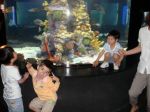
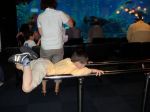

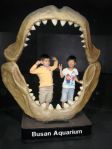
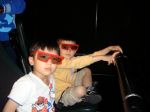

Hmm. That’s not exactly what I wanted, but it does look good. Left-to-right, top-to-bottom, here are some descriptions.
1) We arrived early and walked through the Haeundae Sand Sculpture Festival.
2) The little guy loves doing this pose these days and it is infuriating! Also in the pic are two of his friends.
3) The fish and other animals were great,but so were the railings! It was hard to pull the boys away to see more fish.
4) The Moon jellyfish are in a cylindrical tank and I shot the boys through the tank.
5) Cast of a fossil shark jaw.
6) Just outside of the Aquarium proper is a 3-D video ride. Here are the boys after their ride. We saw a ‘Happy Feet’ based video, but earlier the little guy and I saw a dinosaur video. The video is 3-d but also, you are sitting on a hydraulically controlled platform that can lift and drop and tilt. You really feel like you are moving. In the dinosaur video, we felt like we were in a helicopter and the dinosaurs were all around. It was terrifying for the little guy.
7) Swimming at Haeundae beach.
———
The aquarium is well-done but not large. Don’t come to Busan just for it. Still, it is right on the beach and makes an air-conditioned break from the hot sun.
The little guy and I have season passes (46,000 won each for Koreans, 40,000 won for foreigners). The passes came with two extra free tickets which we gave to the family that came with us. After two visits, and including the price of the free tickets, we are already ahead from using the passes.
I have not tried the ‘shark dive’ experience- you can dive in the main shark tank, full of large grey nurse sharks- but I think I will try it. The nurse sharks here do not look like the nurse sharks I was familiar with in Tobago, where I dove studying the coral reefs as part of my Biology degree.
Haeundae Beach looks great and was about at parity between foreigners and Koreans on Saturday. The water was plenty warm enough and i hope to return several times before the August crowds (Haeundae is the busiest beach in Korea but I suspect will not be crowded until the school break. Koreans seem to think the water is only warm enough between August 1 and August 31). A friend told me about Songdo Beach, which is apparently clean enough to swim in (compared to the much closer DaDaeBeach which looks clear enough, but is in a bad location, pollution-wise), so I will have check that one out.

Muscle memory and chauvinism on a Saturday afternoon.
“Even if she is a killer, she’s still a woman. She’ll come around.”
Quote of the weekend from the Korean horror film, BlackHouse. This film was intended to be background noise to naps in the DVD bang after a day of open air market in Nampo-dong, patio beer at the touristy of tourist restaurants, and freshly severed, still wiggling octopus tentacles with potential to murder us more brutally than the woman in the film. Yet my feeble sleep attempt in the DVD bang was in vain; this film was far too wonderfully terrible to allow my eyes to part with the subtitles.
 As for the octopus. This was terrifying… the poor fellow was just swimming around in its shallow deathbed upon our arrival in search of a thrill. He was hand plucked from the tank and swiftly met his demise under the blade of a knife immediately preceding presentation alongside dipping sauce and soju. They say octopus’ are very smart creatures; strolling through fish markets you begin to notice that each shallow octopus tank has its own octopus babysitter continually blocking escape attempts, shoving the poor bastard back into the water each time its arms drape over the side to try to make a run for it. Pretty morbid. Ingesting wiggling, severed octopus appendages now has a big, red checkmark next to it on my official Korean To-do List.
As for the octopus. This was terrifying… the poor fellow was just swimming around in its shallow deathbed upon our arrival in search of a thrill. He was hand plucked from the tank and swiftly met his demise under the blade of a knife immediately preceding presentation alongside dipping sauce and soju. They say octopus’ are very smart creatures; strolling through fish markets you begin to notice that each shallow octopus tank has its own octopus babysitter continually blocking escape attempts, shoving the poor bastard back into the water each time its arms drape over the side to try to make a run for it. Pretty morbid. Ingesting wiggling, severed octopus appendages now has a big, red checkmark next to it on my official Korean To-do List.

팔용산 Paryongsan
The Gender Politics of Smoking in South Korea: Part 1
 ( Park Soo-ae {박수에} in A Family {가족; 2004}; source )
( Park Soo-ae {박수에} in A Family {가족; 2004}; source )
As numerous expats can attest to, coming to live in Korea can be quite a jarring experience sometimes. But probably not as much as you’d expect, for Korea too is a modern, developed country, with institutions and services that match – nay, are often better – than equivalents in your home country. Comparatively speaking, the transition is really rather smooth.
Scratch below the surface however, and decidedly archaic twists to many aspects of daily life do soon emerge, many of which are profoundly gendered too. For example, after a few months here I began teaching a group of highly intelligent women already fluent in English, who attended my class merely as a hobby. All housewives, later I learned that they likely did so because while Korea has been providing an equal education to both sexes for decades now, and indeed as many as 82% of high-school graduates go on to university, just a few years after graduating women are routinely fired and/or are pressured to resign upon getting married or becoming pregnant. Which makes one wonder what the point of women’s higher education was exactly, and accordingly a study conducted just a few years earlier (Women’s education, work, and marriage in Korea: women’s lives under institutional conflicts by Mijeong Lee, 1998, pp. 161-163) found that, à la Jane Austen, it was largely to secure higher-earning husbands.
 It is true though, that modernization the world over has invariably entailed such “housewifization” and nuclearization of the family, so in that sense at least Korea is arguably simply repeating the experience of societies that developed earlier. One way in which Korea does stand out then, is the case of smoking, and you’re probably well aware that it once had the highest male smoking rate in the world, whereas that for women has historically been extremely low. But unless you are already living in the country, then you may not have realized that this is not necessarily by choice, but rather because women can still get slapped for simply smoking in the street, even in 2010. And as testament to the strength of this taboo, it has influenced the smoking habits of at least one female blogger here too for instance, even though most Koreans excuse expats from the vast majority of Korean social norms (source, right).
It is true though, that modernization the world over has invariably entailed such “housewifization” and nuclearization of the family, so in that sense at least Korea is arguably simply repeating the experience of societies that developed earlier. One way in which Korea does stand out then, is the case of smoking, and you’re probably well aware that it once had the highest male smoking rate in the world, whereas that for women has historically been extremely low. But unless you are already living in the country, then you may not have realized that this is not necessarily by choice, but rather because women can still get slapped for simply smoking in the street, even in 2010. And as testament to the strength of this taboo, it has influenced the smoking habits of at least one female blogger here too for instance, even though most Koreans excuse expats from the vast majority of Korean social norms (source, right).
This brief four-part series is about that gender politics of smoking in Korea, starting in this post with how such an artificial gender binary emerged in the first place; a later one will provide detailed statistics on the number of smokers in Korea, followed by a discussion on the ways in which tobacco companies have (largely successfully) targeted Korean girls and women over the last two decades. As you’ll soon see, it is really a little naive to speak of a “Korean smoking rate” or even “Korean male” or “Korean female” smoking rate when the results differ so widely by age, gender, class, and/or marital status, and the widely perceived notion that Korean women don’t and/or shouldn’t smoke is obscuring the fact that in reality more and more are over time (very roughly 1 in 5), and that success in reducing the number of male smokers comes in the midst of a looming health crisis among female ones.
But first, perhaps “taboo” is not strong enough a word. Consider why the Seoul Metropolitan Council recently proposed banning smoking in public spaces for instance:
“I suggested the bill to protect pregnant women and children from second-hand smoke on streets and at other public spaces” Park Hee-sung, a city councilor, said. “It also secures the right to smoke by designating smoking areas.”
No mere slip of the tongue, this is really a bizarre rationale for banning public smoking: don’t men and non-pregnant women also suffer from passive smoking? But place it in the context of decades-old legislation that posits both children and all women alike as in need of protection however, as mentioned in Kelley Lee et. al. in “The strategic targeting of females by transnational tobacco companies in South Korea following trade liberalisation”, Globalization and Health 2009; 5: 2 (download here), then it does begin to make some sense:
The National Health Promotion Law Enforcement Ordinance, adopted in 1989, bans all tobacco advertising, marketing and sponsorship aimed at women and children including both print and broadcast media.
Although as I’ll explain in Part 4, cigarette companies have largely managed to circumvent this restriction. In the meantime, how did the gender ideology behind the law come about?
 ( Source: iMorpheus )
( Source: iMorpheus )
Well, consider the thoughts of C. Paul Dredge in “Smoking in Korea” published in the Korea Journal back in April 1980, (downloadable here), which are worth quoting at some length. From page 28:
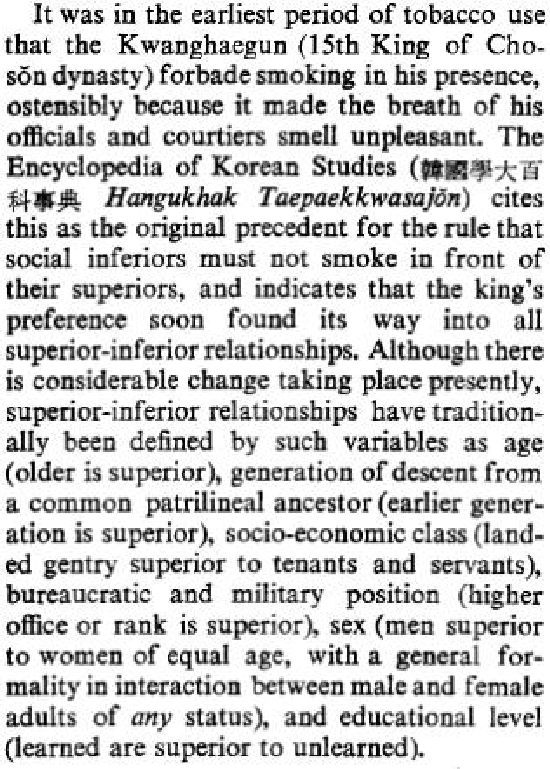
With a clear logic rooted in Neo-confucianism, this explanation intuitively makes sense, and I feel confident that I speak for almost everyone when I say that if that excerpt was all of Dredge’s article that was still available, then we’d be more than satisfied with it.
You can imagine how I felt then, when I read on and learned that that was actually bullshit. From pages 28-29:

A good lesson to remember when trying to understand any society better, and indeed I’ve previously made a similar point in the context of how authority and/or hierarchical relationships are portrayed differently in Korean and Western advertisements, so I should have given it a little more thought myself.
With a newfound respect for Dredge then (does anyone know more about him?), I highly recommend reading his article for yourself to learn more (it’s only 11 pages long), in which he goes on to discuss how the above affected Korean women’s smoking habits (at least in 1980). Also analyzing how they differed in the context of the aforementioned divisions of age, class, and marital status however, then I’ll leave that discussion for Part 3 next week.
For now, I’d be more interested in hearing about your own experiences and opinions of smoking in Korea. Alas, although I’ve never lectured anyone about smoking, I confess that I’m an anti-smoking Nazi myself, and possibly for that reason I only have 2 very occasional smokers among my friends to ask. So I would really appreciate it!^^
Update 1: For those interested in smoking culture in North Korea also, see here.
Update 2: An interesting response to this post by a Korean blogger (in English) is available here.
(Links to other posts in the series as they appear: Part 2, Part 3, Part 4, Part 5)
Filed under: Gender Roles, Gender Socialization, Korean Advertisements, Korean Economy, Korean Families, Korean Feminism, Korean History, Marriage, Sexual Discrimination

Left Flank on KoreaBridge (Audio/Video)
I’m still recovering from my final – a little brain dead and depressed actually. Readers can hear me and my awful headset at around ~17 minutes on Jeff Lebow’s KoreaBridge Live last week.
Filed under: Korea, Podcasts Tagged: busan, jeff lebow, koreabridge

Good Things Are On Their Way!
That feeling is amazing.
What seems like so long ago, and then just yesterday at the same time, I was aching for something and I had no idea what it was. I felt trapped, caged. Freedom seemed so elusive no matter what I did.
I was praying all the time for something to happen, not knowing what it was that I wanted specifically. I tried so many different things, but nothing felt right. Nothing turned out right. I believe now that it was mostly because I didn't know or trust myself entirely. I had no confidence in my dreams and the goals I wanted to reach. And I had no trust in God's timing. I was so impatient that I refused to wait and listen to directions and instead frantically tried to find my own way...only managing to get myself more and more lost.
When I reached one dead end after another I had the choice of giving up or admitting my faults, swallowing my pride, and asking for direction. The direction given was to trust myself, have faith and confidence in my dreams, and learn how to be strong enough to follow after them and accept the hardships and rewards with the same amount of gratitude.
I've finally reached a place in my life where I feel like anything is within my reach. I've also realized that it takes devotion, passion, strength, and patience to achieve goals. There can not be one of those things missing. Accepting that it won't be easy and that hard work is necessary is the first step to the happiness I'm searching for.
Though things are far from perfect, it feels wonderful... to know that anything is possible, to know that I'm going in a good direction, that I'm on a good path.
I'm grateful to my family and friends for supporting me and loving me through everything. No matter where I've been in my life you were there to hold me up, to encourage me, and cheer me on. You continue to do that, giving me strength daily to live life fully and discover more potential within myself to reach even greater heights.
Though I am far away from so many of you, I am thinking of you, appreciating you, and loving you as much as ever. Next time we talk, I hope you can feel proud that you are some of the reason that I am the person I am today, learning how to be a better person tomorrow.
It was a tough week, but I made it through, and better times are ahead!
Everyone keep a smile on. Keep your spirits up.
Good things are on their way.
Until next time,
~Auggie



Recent comments